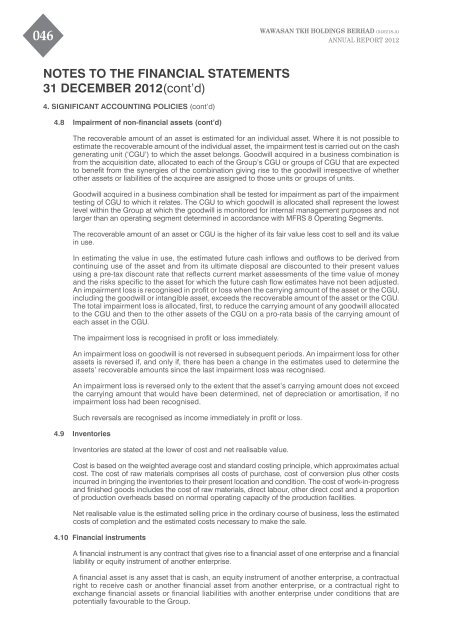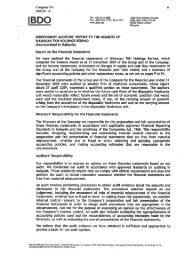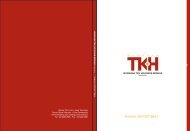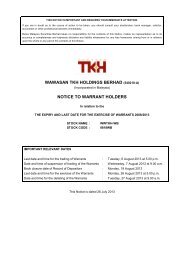ANNUAL REPORT 2012 - Wawasan TKH Holdings Berhad
ANNUAL REPORT 2012 - Wawasan TKH Holdings Berhad
ANNUAL REPORT 2012 - Wawasan TKH Holdings Berhad
Create successful ePaper yourself
Turn your PDF publications into a flip-book with our unique Google optimized e-Paper software.
046<br />
WAWASAN <strong>TKH</strong> HOLDINGS BERHAD (540218-A)<br />
<strong>ANNUAL</strong> <strong>REPORT</strong> <strong>2012</strong><br />
NOTES TO THE FINANCIAL STATEMENTS<br />
31 DECEMBER <strong>2012</strong>(cont’d)<br />
4. SIGNIFICANT ACCOUNTING POLICIES (cont’d)<br />
4.8 Impairment of non-financial assets (cont’d)<br />
The recoverable amount of an asset is estimated for an individual asset. Where it is not possible to<br />
estimate the recoverable amount of the individual asset, the impairment test is carried out on the cash<br />
generating unit (‘CGU’) to which the asset belongs. Goodwill acquired in a business combination is<br />
from the acquisition date, allocated to each of the Group’s CGU or groups of CGU that are expected<br />
to benefit from the synergies of the combination giving rise to the goodwill irrespective of whether<br />
other assets or liabilities of the acquiree are assigned to those units or groups of units.<br />
Goodwill acquired in a business combination shall be tested for impairment as part of the impairment<br />
testing of CGU to which it relates. The CGU to which goodwill is allocated shall represent the lowest<br />
level within the Group at which the goodwill is monitored for internal management purposes and not<br />
larger than an operating segment determined in accordance with MFRS 8 Operating Segments.<br />
The recoverable amount of an asset or CGU is the higher of its fair value less cost to sell and its value<br />
in use.<br />
In estimating the value in use, the estimated future cash inflows and outflows to be derived from<br />
continuing use of the asset and from its ultimate disposal are discounted to their present values<br />
using a pre-tax discount rate that reflects current market assessments of the time value of money<br />
and the risks specific to the asset for which the future cash flow estimates have not been adjusted.<br />
An impairment loss is recognised in profit or loss when the carrying amount of the asset or the CGU,<br />
including the goodwill or intangible asset, exceeds the recoverable amount of the asset or the CGU.<br />
The total impairment loss is allocated, first, to reduce the carrying amount of any goodwill allocated<br />
to the CGU and then to the other assets of the CGU on a pro-rata basis of the carrying amount of<br />
each asset in the CGU.<br />
The impairment loss is recognised in profit or loss immediately.<br />
An impairment loss on goodwill is not reversed in subsequent periods. An impairment loss for other<br />
assets is reversed if, and only if, there has been a change in the estimates used to determine the<br />
assets’ recoverable amounts since the last impairment loss was recognised.<br />
An impairment loss is reversed only to the extent that the asset’s carrying amount does not exceed<br />
the carrying amount that would have been determined, net of depreciation or amortisation, if no<br />
impairment loss had been recognised.<br />
Such reversals are recognised as income immediately in profit or loss.<br />
4.9 Inventories<br />
Inventories are stated at the lower of cost and net realisable value.<br />
Cost is based on the weighted average cost and standard costing principle, which approximates actual<br />
cost. The cost of raw materials comprises all costs of purchase, cost of conversion plus other costs<br />
incurred in bringing the inventories to their present location and condition. The cost of work-in-progress<br />
and finished goods includes the cost of raw materials, direct labour, other direct cost and a proportion<br />
of production overheads based on normal operating capacity of the production facilities.<br />
Net realisable value is the estimated selling price in the ordinary course of business, less the estimated<br />
costs of completion and the estimated costs necessary to make the sale.<br />
4.10 Financial instruments<br />
A financial instrument is any contract that gives rise to a financial asset of one enterprise and a financial<br />
liability or equity instrument of another enterprise.<br />
A financial asset is any asset that is cash, an equity instrument of another enterprise, a contractual<br />
right to receive cash or another financial asset from another enterprise, or a contractual right to<br />
exchange financial assets or financial liabilities with another enterprise under conditions that are<br />
potentially favourable to the Group.







